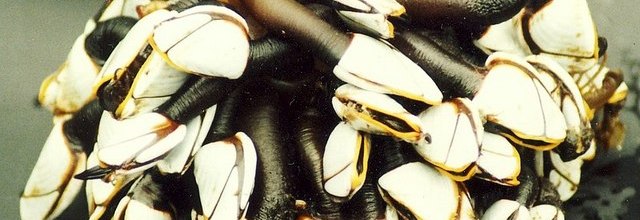References
Alvarez F. E. RobertoOntanon P. and JoseMolares V.
Archaeological data on the exploitation of the goose barnacle
Pollicipes pollicipes (Gmelin, 1790) in Europe. Journal of
archaeological science 37.2 (2010):402-408. Accessed March 8,
2012
Cruz, T. Joao C. and Stephen J. Hawkins. Recruitment, growth and
population size structure of Pollicipes pollicipes in SW Portugal.
Journal of experimental marine biology and ecology 392.1-2
(2010):200-209. Accessed March 8, 2012
Jacinto, D. et al. Management of the stalked barnacle (Pollicipes
pollicipes) fishery in the Berlengas Nature Reserve (Portugal):
evaluation of bag and size limit regulation measures. Scientia
marina 75.3 (2011):439-445 Accessed March 8, 2012
Lopez, D. A, et al. Barnacle culture: background, potential and
challenges. Aquaculture research 41.10 (2010):e367-e375. Accessed
March 8, 2012
Van-Syoc, R J, et al. Molecular phylogenetics and biogeography of
Pollicipes pollicipies (Crustacea: Cirripedia), a Tethyan relict.
Journal of experimental marine biology and ecology 392.1-2
(2010):193-199. Accessed March 8, 2012
Goose Barnacle database 2010.
D. V. Lavrov database 2004.
Campbell and Reece 2008. Biology. 8th edition. Beth Wilbur,
editor in chief. Sansome St., San Fransico, CA, USA. Accessed March
23, 2012
Ross, A. and Emerson, K W. 1974. Wonders of Barnacles. Dodd, Mead
and Company, New York, USA. Accessed April 3, 2012
Schaefer, M L. 2002. Barnacles. Reed Educational and Professional
Publishing, Chicago, Illinois, USA. Accessed March 30, 2012
Shahan, S. 1996. Barnacles Eat With Their Feet. The Millbrook
Press, Brookfield, Connecticut, USA. Accessed April 4, 2012
Maurice and Robert Burton. 1980. The New International Wildlife Encyclopedia Volume 2. Macdonald Raintree Inc. Milwaukee, Toronto, Melbourne, London.
Click here to continue to Contact Me.
